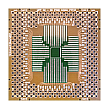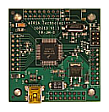Alternatives & Competition.
First some general breadboarding methods and a bit of history:
(See the Wikipedia page  for more detail.)
for more detail.)
- The term “breadboard” has its origin in the method of building one-off circuits in the vacuum tube era, and even earlier. Think of Alexander Graham Bell's circuits. Later, vacuum tube sockets and passive parts would be fastened down to a chunk of wood and wired together with fabric-insulated wires (or solid wires as in the photo). (I was bemused to learn, when I was working on a Navy job, that the term there was “brassboard”. I had the impression that this was one step up from a breadboard. That term, to me now, though, invokes thoughts of Steampunk!)

- Nowadays solderless breadboards are considered by many the way to go. They are fairly expensive (more than a chunk of wood), force a certain layout style which is not always sensible, tend to come apart when least expected and suffer from a low areal density. Because they are designed around through-hole devices they are not compatible with non-DIP components without using adapters (commonly called break-out boards). This really becomes apparent when you try to mount something as common as a USB connector. As well, high-speed circuits often don't work in the high parasitic capacitance environment of the socket strips.

- There are several boards which are meant to copy a circuit which has been built on a solderless breadboard. These are just a plain waste of time to anybody but the first-time user: why copy a less than ideal layout? They also suffer from the same low density and non-DIP package problems as their model, though the parasitic capacitances will be lower. OK, OK, I guess they have a place, like when the circuit just has to be moved off of the last available solderless breadbord strip, and in a hurry!

- Once upon a time, wire-wrap panels were considered the ideal breadboarding system.
Now, however, this system has fallen by the wayside. Signal frequencies, device sizes and
package types have all combined to kill this method of constructing circuits. Don't throw out any
30-Guage wire wrap wire you may have, however, as it is the ideal jumper wire for many of the
Li'lBoards. (No picture here: the ones on the Wikipedia page on the
subject
 are excellent.)
are excellent.) - Boards such as those from Vector or Vero have long been the breadboarding/prototyping method of choice in industry. The traditional Vero boards have strips of copper on one side and puched holes on a 1/10" grid. One cuts the tracks, either at a hole or between holes to isolate sections of the circuit being built. A real mental workout can be obtained by the two-sided Vero boards that have tracks running across one side and up/down on the other side!
Now some specific products from all over the world.
I've scoured the web for any system of boards that even comes close to the utulity, flexibility and affordability of this system. Here are the results of that search, but please note that this is an evolving field, some of my results may be gone by the time you read this or much changed:
- Possibly the closest system is the SchmartBoard line-up. These use a custom clip to join 2" × 2" boards together, and longer dimensions must be a multiple of this. They also use a special PCB process in that their solder mask is extra thick, which causes the leads of fine pitch components to index into slots which bring them into alignment with the appropriate solder pads. Mostly they produce only breakout boards. The main exception is that they also make a Propeller board which uses their 2x2 form factor and their long-tailed land-wells for soldering the processor and the requisite serial eeprom.

- E-blocks, from a UK company, Matrix Multimedia, are a neat modular system. They are not intended to be used in industry, nor are they affordable by hobbiests: they seem solely intended for the education market. The mounting methodology might seem similar to that used by Li'lBoards, because a regular grid of holes is used, but the boards are made in many various sizes, and their fully contained mounting holes are simply spaced at multiples of the 20 mm mounting grid size. Their interconnection method is by means of DE-9 pin connectors, which seems to be limiting (but rugged). (Note there are a couple of academic systems that use a name similar to E-blocks, one from UC Riverside in California, one from Australia.)

- The ForeRunner series from Atria Technologies Domain is for sale (noted October 2017--last good snapshot in the Wayback Machine was December 2014!) is similar in a way, but they use interior holes and mount with plastic standoffs. I spotted 18 different board designs, 7 of which are Freescale processors. They are a Freescale-only operation and it may be that their “BASIC OS” came first. It seems that the repeat size on the mounting hole grid is something close to 1.6". Their platforms look like they could be adapted to Li'lBoards with a little bit of re-drilling: but so can virtually anything. The boards are identified as either 2"×2" or 2"×4". A lot of wasted space between boards! The stated philosophy, that each board is built “with the minumum components to allow for simple integration” is an accurate statement of a part of the Li'lBoard philosophy.

- Phidgets are a module family that specialize in sensing and control via USB. Power is also via USB. As far as USB controllers there is one very capable SBC which has all the bells and whistles (like 6 USB host ports and an Ethernet port), however many users will be using a PC as USB master. Bonus: they are Canadian.

- B-Squares, from “Octo23 & Haddock Invention” and sold by Seeed Studio, use magnetic contacts to conduct power and a few signals between units and to hold them together. Multiple connections are handled in the traditional way using headers, as evidenced by the pictured Arduino work-alike.

- Another system that uses magnets is called littleBits. Aimed largely at early education, these toy-like bits (think Lego with magnets and connections) seem to have no processors at all. The creativity shown on the site, with sample projects and such, is quite high. One kudo is that they are open source, but that hardly seems to be relevant since the special connectors seem to be not for sale, nor do there seem to be mechanical drawings/ 3-D printer files available for these. And $14 for a single LED? Really! (And worse: the same price for a few inches of wire with a special connector on each end.)

- The “Grove” boards from Seeed Studio are another system. They, however, require a ribbon cable to connect each and every module to a mother board.
- There are a lot of add-ons to Basic Stamp and similar controllers, however, these are mostly I/O oriented, and somehow tied to their parent's design. The Basic Stamp itself requires a large DIP socket or solderless breadboard to be used. Of course, the biggest current example of this are the many Arduino shields.
There has been no universal form factor breadboarding system which covers all the markets equally, until now. So…there isn't any direct competition!
Page visited: Saturday, May 17th, 2025 at 9:39pm PST. Last updated: Jan 30, 2021.
